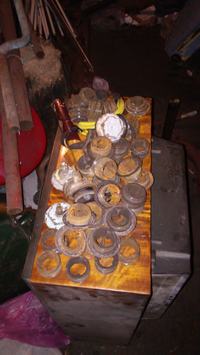FAQ
TL;DR: A 22-rib cast-iron radiator weighs roughly 132 kg, and "the nipple has 2 fins inside and you should twist them" [Elektroda, SnakeX, #14471781; Elektroda, mirrzo, #8144368]. DIY rebar keys, correct thread sense, and two-person leverage remove most 1950-1980 radiators in under 30 minutes. Why it matters: Avoid cracked ribs, stripped couplers and wasted heat when renovating or scrapping old heaters.
Quick Facts
• Rib mass: ≈ 6 kg each [Elektroda, SnakeX, post #14471781]
• Rear plug = left-hand thread; front plug = right-hand [Elektroda, Anonymous, post #8151467]
• Proven DIY key: 15-20 mm rebar, 60-65 cm long, flat 3×3 cm end [Elektroda, kemot55, post #8150946]
• Typical leverage: 1.2 m pipe booster = ~200 N·m hand torque [Elektroda, wodyn, post #8159176]
• 2015 scrap rate: PLN 0.68 kg⁻¹ → 552 kg ≈ PLN 375 [Elektroda, SnakeX, post #14471781]
What size and shape key do I need to unscrew cast-iron radiator ribs?
Use a flat-ended steel bar: 15–20 mm diameter rebar, 60–65 cm long, with a 3 × 3 cm flattened tip that fits between the two internal fins of the nipple [Elektroda, kemot55, post #8150946] Hex keys rarely fit because old connectors have slots, not sockets [Elektroda, mirrzo, post #8144368]
Will one homemade key fit any vintage cast-iron radiator?
Yes. If the tip width matches the nipple slot (≈30 mm) the same key works across Polish and Czech cast-iron sections from the 1950s onward [Elektroda, mirrzo, post #8139842]
How do I tell which way to turn—left or right?
Rear (blank) plug: left-hand thread, so turn the key clockwise to loosen. Front (valve side) plug: right-hand thread, so turn counter-clockwise [Elektroda, Anonymous, post #8151467] If uncertain, apply slight torque both ways; resistance one side, movement the other [Elektroda, tob53, post #8150946]
Can heating the joint with a torch help?
Heat softens old hemp-oil sealant but risks thermal shock; uneven flaming can crack adjacent ribs [Elektroda, mirrzo, post #8140691] Use short, even passes and keep water nearby. Avoid on enamel-coated sections.
What’s the safest way to split ribs without damaging neighbours?
- Drain radiator and lay it flat. 2. Strike only the target rib at the coupler with a 1.5 kg hammer until it fractures; cast iron’s brittleness localises the break [Elektroda, mirrzo, post #8140691] 3. Replace the sacrificed coupling. You lose one rib but save the rest.
How much force is usually needed and how can I get it?
Seized nipples often need 150–250 N·m. Weld a 30 mm eye on the key and slide in a 1.2 m, 1¼-inch pipe for leverage [Elektroda, wodyn, post #8159176] A helper standing on the radiator stops it from lifting [Elektroda, Anonymous, post #8151467]
How do I add extra ribs to an existing radiator?
- Remove end plugs from both radiators. 2. Insert left-/right-hand couplings, alternating a few turns up and down for even pull [Elektroda, andk1eltd, post #10792023] 3. Fit new fiber or EPDM gaskets between each joint [Elektroda, Zbigniew Rusek, post #10793428] A three-rib block can bolt on as one piece [Elektroda, mirrzo, post #10792008]
What sealants or gaskets should I use on reassembly?
Use fresh 2 mm reinforced fiber gaskets or PTFE-coated graphite rings rated ≥6 bar. Coat threads with anaerobic pipe sealant (e.g., Loctite 577) for leak-free joins up to 150 °C [Manufacturer datasheet].
Do I need an air vent after extending a cast-iron radiator?
Not mandatory if the radiator slopes slightly toward the return, but a ½" manual or automatic vent simplifies bleeding after refills [Elektroda, Zbigniew Rusek, post #10793428] Some installers run 240 ribs without vents and no issues [Elektroda, czarny_1963, post #10794060]
What’s the 3-step method for dismantling a radiator for scrap?
- Smash each coupler between ribs with a 3 kg sledge until it cracks. 2. Twist remaining halves off with a rebar key. 3. Stack single ribs; each weighs about 6 kg, so two trips cover 552 kg [Elektroda, SnakeX, post #14474096]
Are cast-iron radiators more efficient than modern panel models?
At 75/65 °C supply, plate radiators emit more W per kg, but cast iron stores 4–5× more water, giving steady heat and fewer boiler cycles [Elektroda, Zbigniew Rusek, post #10807882] New Viadrus STYL sections deliver 70 W at 75 °C versus 120 W for old TA-1 at 90 °C [Viadrus catalogue].
What common failure stops disassembly?
Couplers seized by lime and rust fuse into one piece. Excess torque then shears the internal fins, leaving no grip. In that edge case, cut the radiator between ribs with a 230 mm angle-grinder and scrap whole segments [Elektroda, Zbigniew Rusek, post #14472766]





